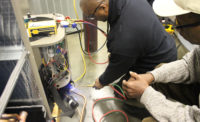Defining ‘green’ within the HVAC industry is not something that comes easily or with a black-and-white answer. Green is really more of a grey area, especially for HVAC contractors. While some enthusiastically believe green still means go, others feel the terminology that once created a spark has all but fizzled out.
More than a Color
“I define green as increased efficiency for the home or building,” said Michael Bowman, president, Dunedin Refrigeration, Dunedin, Florida. “It has become an all-encompassing term covering a wide range of things, including high-efficiency air conditioning equipment; energy-efficient improvements, such as windows, insulation, Energy Star-compliant appliances, sealing air leakage in the structure or duct system; and more.”
“We define green as any improvement that saves energy, decreases carbon footprint, and increases overall efficiency”, said Domenic DeLeo, department manager, Isaac Home Energy Performance, Rochester, New York. “Most customers don’t see green as the main driver for making a decision on improvements; typically, it’s an additional benefit. With that said, we focus on comfort and efficiency, tying green into the efficiency part of the discussion.”
To Matt Marsiglio, operations manager, Flame Heating, Cooling, Plumbing, and Electrical, Warren, Michigan, green means maximizing a system’s energy output.
“We make sure to explain to each customer how these upgrades provide an increase in comfort level and the potential return on investment.”
From Buzzword to Efficiency
Green is an important aspect of HVAC that some believe can still be a key selling point inside the home.
So, how can green be best transferred from an idea into an actual application? It all comes down to tying it into efficiency and potential savings for the customer.
“Green is still an effective buzzword,” said DeLeo. “However, green on its own isn’t an effective upsell tool. You have to tie it to efficiency and savings. Green can be used to help close deals, giving customers one more reason to feel good about their purchases.”
“I think the wide range that is covered by the term can be used effectively depending on what improvements you are describing,” said Bowman. “It creates a picture of efficiency in the mind of the customer. I have seen too many instances where the term is used to try to sell something that is not really that beneficial to the home or building owner. The intent of ‘green’ is to increase efficiency and lower the usage of energy or lessen the carbon footprint. I don’t feel it applies when the product you are pitching does not accomplish these ideals or does not benefit the consumer.”
Once customers can see the long-term gains from higher-efficiency products, there is a lot that can be done utilizing “green” ideology.
“I have a large commercial customer who is very enthusiastic about green building and has built some LEED [Leadership in Energy and Environmental Design]-rated buildings,” said Bowman. “We have done the air conditioning systems for them and continue to maintain the systems. They are very familiar with the term ‘green,’ and our discussions center on what is the most efficient and beneficial way to do the work. He will upgrade if shown ways to make buildings more efficient with a better payback in the long run. I have done some home air conditioners for architects and engineers, and they awarded me the jobs based on the fact that I am a LEED AP and none of my surrounding competitors are.”
“We use it [green terminology] in conjunction with efficiency. It’s tied into every job we sell,” said DeLeo. “One customer living in a new, efficient home wanted to add geothermal and solar — two of the greenest products we offer — at a cost of $95,000. While the payback was the life of the equipment, we made sure the customer understood that. His concern was the environment, so we demonstrated the carbon savings on the system and he moved forward with the job.”
Overripe
Some contractors have soured on the idea of green sales, citing skepticism that the term’s effectiveness has lapsed.
“I find that ‘green’ has run its course for marketing of energy-saving HVAC systems, and many other so-called energy-saving and supposedly environmentally friendly products,” said Robin Boyd, technical service advisor for U.S. Supply Co.
“[Green is still an effective tool to upsell efficiency] to a point, but there is a segment of consumers who do not have much interest in going green,” said Marsiglio.
As attention to efficiency continues to spread, Bowman encouraged contractors to continue equipping themselves with as much knowledge as possible.
“Never stop learning,” he said. “The industry is evolving, and you can’t just sit back and do things the same way we always have. I’ve been an air conditioning contractor for 30 years in this area, and I’ve taken numerous classes and certification tests this year. I am a certified HERS rater and attended a BPI [Building Performance Institute Inc.] building analyst certification class this month, as well. The realm of the air conditioning contractor is changing, and you need to lead, follow, or get out of the way. I personally believe in leading, but I’m fine with all my competitors being followers.”
“Efficiency and green should be used in conjunction,” said DeLeo. “Most clients are interested in saving green [cash] and then being green. Lead with comfort and efficiency, and remember, green is added value.”
Publication date: 9/29/2014
Want more HVAC industry news and information? Join The NEWS on Facebook, Twitter, and LinkedIn today!









